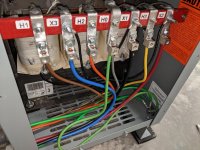That is actually a good choice, because the secondary is a Wye which is what you want. You WOULD ground the X0 on the secondary side on that transformer.
208V Delta is referring to the configuration of the windings in that transformer. That is a separate issue from what is the configuration of your SERVICE. Your service is irrelevant to the transformer internal connections, other than the voltage level.
OK, I ended up ordering the Federal Pacific Model T20LH42-15 transformer this afternoon. In an email exchange between my vendor and a manufacturer rep I posed the same questions. This was the response:
“Concerning the T20LH42-15 Perfectly suitable for 208 input across x1,x2,x3 (no neutral input needed) and yes the transformer will generate a neutral on the secondary.That transformer does have a stud welded to the case for a ground, does not need to be separated from service ground as far as the transformer is concerned. That unit has taps +2,
[email protected]%. So the output could technically vary up or down 5% with tap manipulation.”
...which is exactly what both of you said.


***Hopefully this thread is not too confusing for someone years down the road. I started off by asking for wiring information on a different transformer make and model... and reverse feeding it at that.***
NOW THEN - With this 208D to 480/277Y STEP UP transformer this is what I plan to do. Let me know if it sounds correct-ish.
1) Mount the transformer in my shop with about 12" of clearance from any walls. I will probably use some rubber pads underneath the supports when I anchor it down.
2) Install a ?50A?, 3-pole breaker in the nearest sub-panel. Should I be using a larger breaker or a special type of breaker for inrush current?
3) Bring all three phases from that ?50A? breaker AND the ground from that sub panel to a fused disconnect loaded with time delay 50A fuses. I know this part is redundant, but I don't know how else to feed it from the sub panel (or any of our existing panels) without using a breaker. I suppose the breaker would be enough, but I like having the big "shut 'er down!" handle nearby.
4) From the disconnect I will continue on to the transformer with #4 wire for each phase and the ground, at which point they will terminate on X1, X2, X3, and the ground wire to the welded stud inside the case.
5) On the high side, I will connect #4 wires to H0 for neutral, H1, H2, and H3 for the three phases, and a ground wire from the same welded stud in the case, right???
6) Then land those FIVE wires in a small panel that is rated for 480/277.
Before I ask any other questions, does that part sound good?
Thanks again to both (all) of you for taking the time to respond and walk me through this process.



 One thing about this transformer though, besides the X0 lug and a ground lug on the enclosure itself, there is a metal strap that connects the support frame (where the coils are situated) to the enclosure. That metal strap stays, correct? It does not touch the X0 as best I can tell. I took some pictures if I need to post them up I will.
One thing about this transformer though, besides the X0 lug and a ground lug on the enclosure itself, there is a metal strap that connects the support frame (where the coils are situated) to the enclosure. That metal strap stays, correct? It does not touch the X0 as best I can tell. I took some pictures if I need to post them up I will. 






